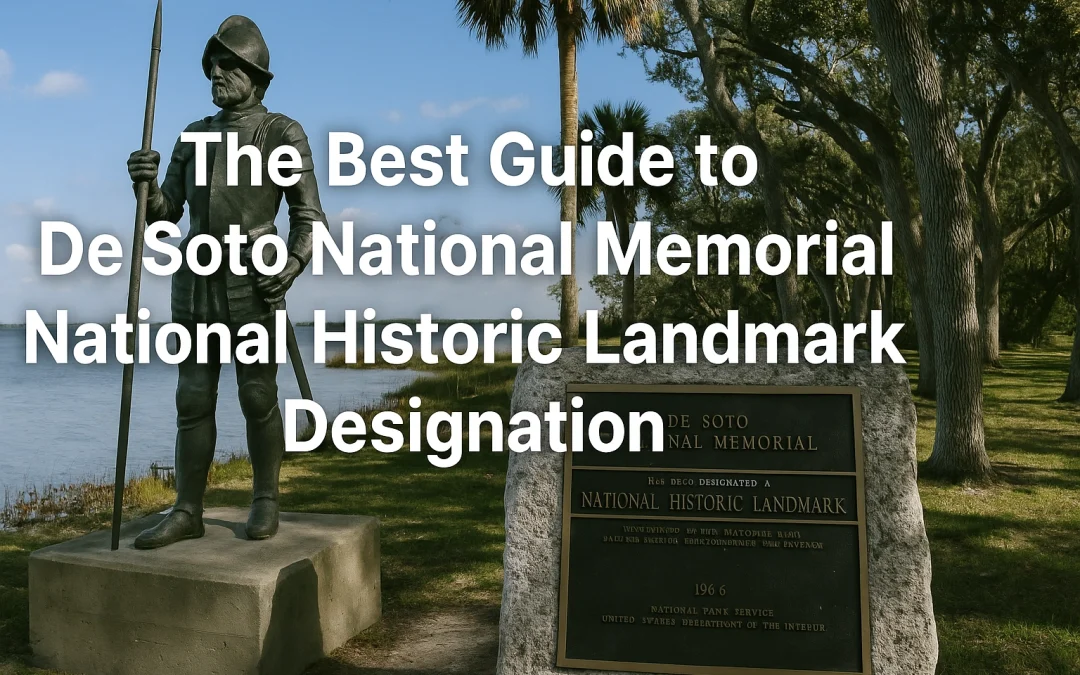Introduction: The Designation of the De Soto National Memorial and Its Enduring Significance
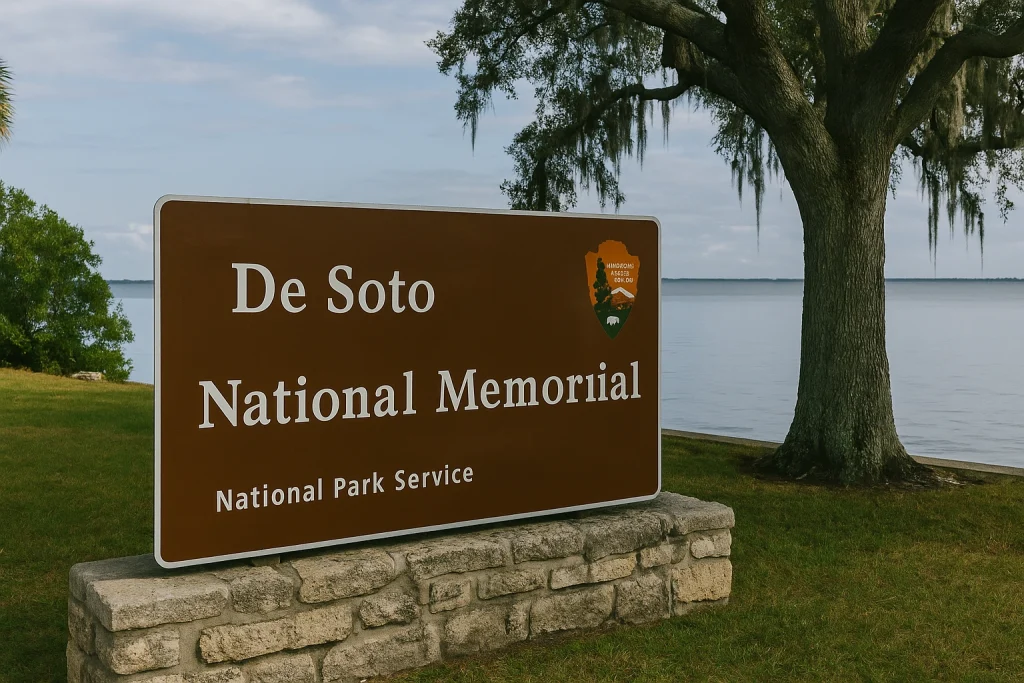
The De Soto National Memorial national historic landmark designation stands as a profound acknowledgment of one of the most pivotal moments in early American history. Nestled along the shores of the Manatee River in Bradenton, Florida, this site marks the approximate landing area of Spanish conquistador Hernando de Soto, whose 1539 expedition was among the first major European incursions into what would become the southeastern United States. Beyond its scenic coastal beauty, the memorial embodies centuries of layered history—spanning Indigenous heritage, European exploration, cultural encounter, and the evolution of America’s preservation movement.
The designation of the De Soto National Memorial as a nationally recognized historic site reflects far more than a ceremonial title. It is a commitment to safeguarding the landscape, archaeology, and stories that shaped the nation’s early identity. Managed by the U.S. National Park Service, the memorial preserves both tangible and intangible traces of a past that continues to inform our understanding of exploration, colonization, and cultural exchange. Visitors walking its mangrove-lined trails are not simply exploring a park—they are traversing the living memory of first contact between European explorers and Native American societies, a chapter that altered the course of North American history.
From the archaeological investigations uncovering ancient shell middens and 19th-century tabby ruins, to the interpretive programs that recreate the 16th-century Spanish encampment at Camp Uzita, every element of the site contributes to a richer public appreciation of this complex heritage. The De Soto National Memorial national historic landmark designation thus serves as both recognition and responsibility—a recognition of historical significance, and a responsibility to preserve, educate, and inspire. In this comprehensive guide, we delve into the memorial’s origins, the story of its landmark designation, the cultural narratives it represents, and the ongoing efforts that ensure its legacy endures for future generations de soto national memorial national historic landmark designation.
2. Historical Background: The 1539 Landing & the Expedition of Hernando de Soto
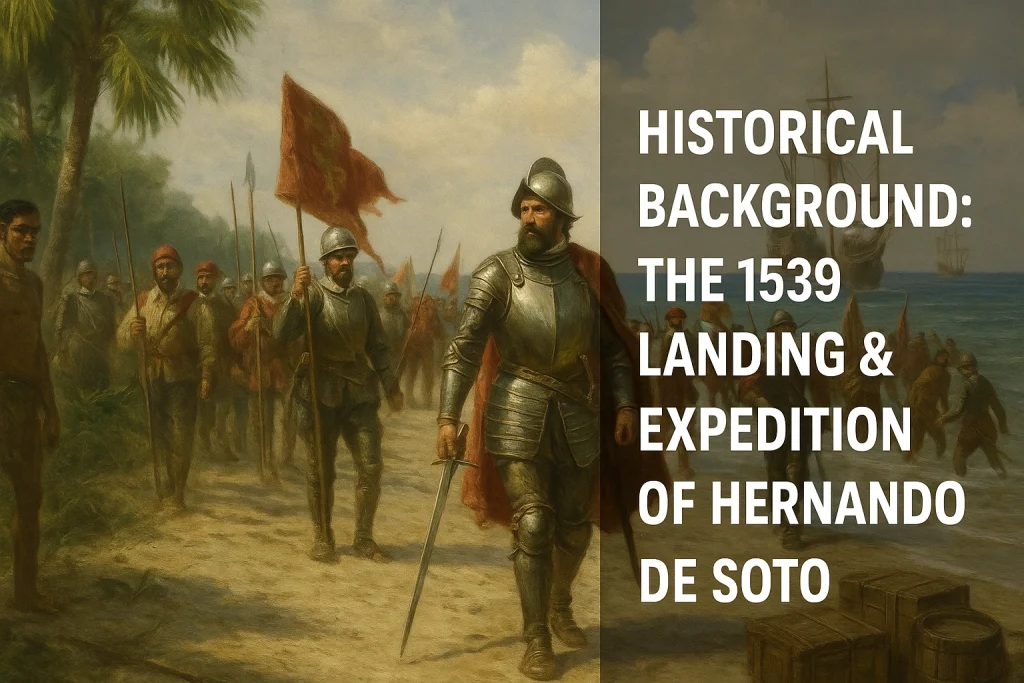
In May 1539, Hernando de Soto led an expedition of over 600 men into what is now the southeastern United States, landing in Tampa Bay and setting off on a four-year, 4,000-mile journey through territory that would become Florida, Alabama, Georgia, and beyond. This expedition is widely regarded as the first large-scale, organized European exploration into the southern interior of what would become the United States.
De soto national memorial national historic landmark designation Although de Soto hoped to find gold, silver and new colonies, his expedition found more resistance, disease, and cultural collision than riches. The story of the landing, the march, the encampments and the ultimate fate of his party is both dramatic and tragic—but central to the significance of the site now recognized by the designation of the De Soto National Memorial national historic landmark designation.
3.The Site: Location, Landscape and Archaeological Resources of De Soto National Memorial
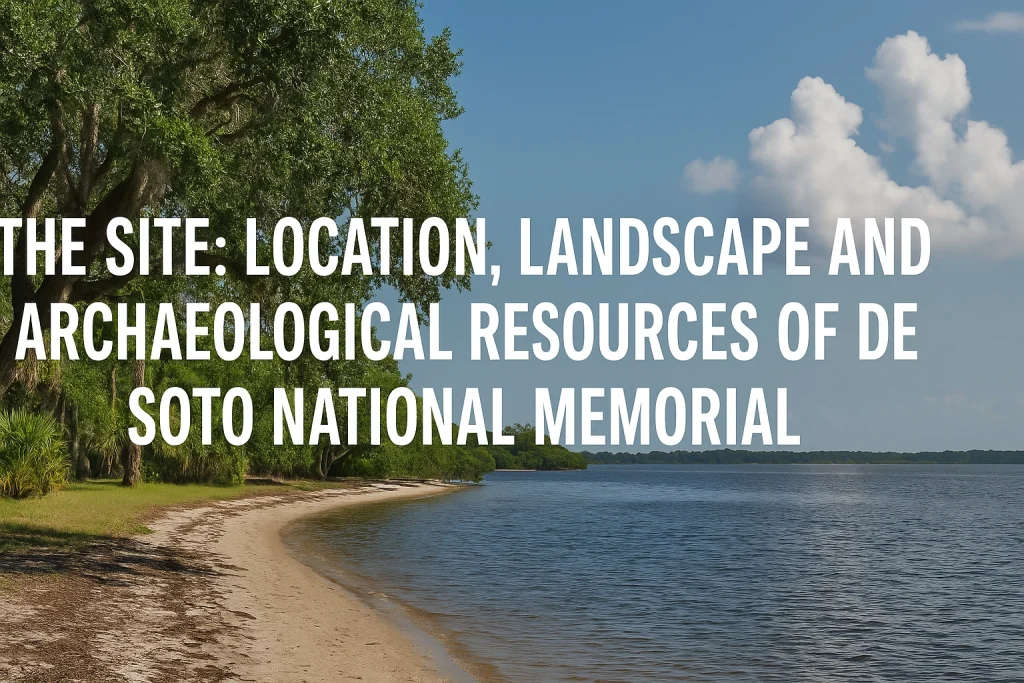
Located in Manatee County, Florida, just west of Bradenton, the De Soto National Memorial lies at the mouth of the Manatee River as it meets Tampa Bay. The site comprises roughly 26 to 30 acres, with over 3,000 feet of shoreline and about 80 % of the land consisting of mangrove swamp, pine uplands, mixed hardwoods and shell ridges. Within this setting, archaeologists have identified the Shaw’s Point Archaeological District, shell middens (some dating back to 365 B.C.), and tabby-house ruins from the mid-19th century.The physical setting matters because it provides the tangible landscape in which the 16th-century contact took place de soto national memorial national historic landmark designation .
The natural environment—swamps, mangroves, estuary shoreline—would have been the world de Soto’s men encountered. The De Soto National Memorial national historic landmark designation therefore rests not only on the event of the landing, but also on the preservation of the landscape and archaeological resources that link the place to that moment in history.
4.From Proposal to Listing: How the De Soto National Memorial Gained Historic Status
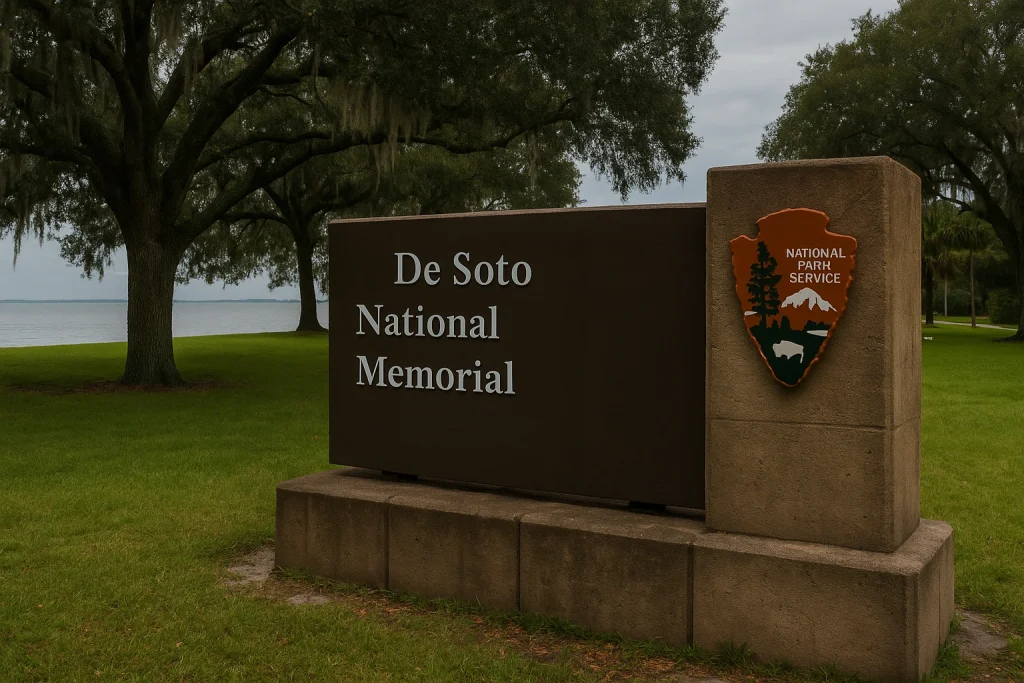
4.1What is a National Historic Landmark / National Register listing?
To understand the designation of the De Soto National Memorial national historic landmark designation, we need a brief primer. In the United States, the National Register of Historic Places (NRHP) is the official federal inventory of historic places worthy of preservation. A separate but related recognition is the National Historic Landmark (NHL) program, which acknowledges sites of exceptional national significance. Wikipedia
For a site to become an NHL (or be listed on the NRHP), it typically must satisfy criteria relating to its significance, its integrity, and its ability to convey story(s) that matter to history, architecture, archaeology, culture or engineering. This legal or administrative framework is what makes the phrase de soto national memorial national historic landmark designation meaningful—it signals that a site has been officially recognized as part of the national heritage.
4.2Timeline of Designation for De Soto National Memorial
Here’s a roughly chronological breakdown of how the De Soto National Memorial designation came about:
-
In 1939, the 400th anniversary of de Soto’s landing was commemorated with a monument erected by the National Society of the Colonial Dames of America.
-
On March 11 1948, Congress authorized the establishment of the De Soto National Memorial as a national memorial.
-
On October 15 1966, following the signing of the National Historic Preservation Act, the area was listed on the National Register of Historic Places (as part of the Shaw’s Point Archaeological District) under refnum 66000078.
-
Note: While many sites become full National Historic Landmarks , the De Soto National Memorial currently retains the National Memorial designation rather than the full NHL label, because exact landing location is still under scholarly debate.
4.3Why the Site Was Designated (Significance Criteria)
The designation of the De Soto National Memorial national historic landmark designation is based on multiple layers of significance:
-
Historically, de Soto’s expedition was the first large-scale European foray into the interior of what is now the Southeastern U.S., marking the start of European-Native American contact, which dramatically changed indigenous lifeways.
-
Archaeologically, the site includes important resources such as shell middens, early habitation evidence and the tabby house ruins which speak to a long sequence of use.
-
Culturally and socially, the site reflects themes of exploration, colonization, indigenous resistance, environment and change—so its preservation offers an interpretative platform for historical complexity.
Therefore, the designation is not only about the landing event, but about how that event is situated within a physical, cultural, and historical landscape worthy of recognition and preservation de soto national memorial national historic landmark designation.
5.Interpretation & Preservation: How the Memory of the Expedition is Kept Alive
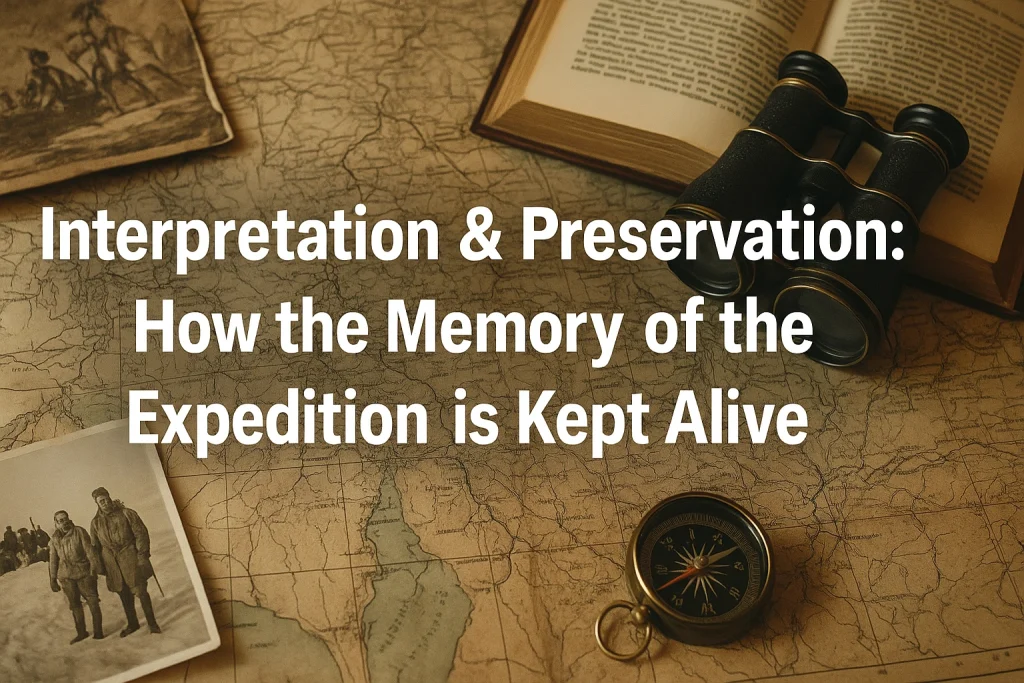
5.1 Living History and Visitor Programs
Visitor engagement is a key reason the site continues to attract attention. At De Soto National Memorial, programs such as Camp Uzita bring to life the moment of first contact through reenactments, costumed rangers, and interactive demonstrations blacksmithing, cooking, weapons display.
The Visitor Center exhibits armor, 16th-century weaponry and period artifacts, offering both educational and immersive experiences. These interpretive strategies help the site move beyond a static designation to an active educational resource, strengthening its value and justifying its recognition under the national historic landmark or equivalent status.
5.2 Archaeology, Conservation and the Tabby House Ruins
Preservation is also a matter of managing tangible resources. For example, the tabby house ruins of William H. Shaw (1843) supplement the deeper pre-contact and early contact layers. The Natural Park Service’s foundational document emphasises fundamental resources and values such as the estuarine and mangrove environment, the archaeological record, and the contact narrative. In doing so, conservation of these resources supports the site’s continuing integrity, which is critical for maintaining the designation. In short, the designation of the De Soto National Memorial national historic landmark designation is sustained by ongoing preservation efforts.
6. Visitor Experience & Practical Information: Touring the Landmark Site

6.1 Visitor Center, Exhibits and Camp Uzita
When you plan a visit to the site, you’ll want to start at the Visitor Center address: 8300 De Soto Memorial Hwy, Bradenton, FL 34209 where you can view exhibits about de Soto’s expedition, pick up a map, watch an orientation film, and perhaps don chain-mail for a photo. From there, you can visit Camp Uzita seasonal: December through April to watch costumed rangers and volunteers enact the first Spanish camp.
6.2 Trails, Wildlife and the Manatee River Shoreline
The park offers a short nature trail along the shoreline of the Manatee River and Tampa Bay, where you can imagine the mangroves and shore the expedition encountered. Bird-watching, fishing, picnicking and serene views make the site appealing to both history-seekers and nature-lovers. Best of all, admission is free.
6.3 Tips for Planning Your Visit
-
Visit during the cooler months December–April if you want to catch the living history programs.
-
Use the one-mile trail linking to Riverview Pointe Preserve if you seek a longer walk.
-
Bring sunscreen, bug spray and water—Florida’s coastal environment is beautiful but humid.
-
Allocate 2–3 hours for a full experience Visitor Center, Camp Uzita, trail.
-
Because the designation emphasises history plus landscape, consider taking a guided walk if available to learn about the site’s landmark status and preservation efforts.
7.The Legacy: Cultural Impact, Indigenous Perspectives and Ongoing Research

The designation of the De Soto National Memorial national historic landmark designation also opens up conversations about the legacy of European exploration and its effects on Native American societies. The foundational document notes that de Soto’s expedition caused social and cultural instability among indigenous peoples and drastically impacted native populations within 200 years.
Understanding that legacy is part of the reason the site is managed and interpreted carefully: it’s not just a celebration of discovery, but a complex story of encounter, conflict and change. Archaeological and historical research continues to refine our understanding of the landing site, the route of the expedition and the native peoples encountered—thus the designation remains dynamic, not static.
8. Frequently Asked Questions (FAQ) on the Designation and Visit

Q1: Is the De Soto National Memorial officially a National Historic Landmark?
A: While the memorial is listed on the National Register of Historic Places refnum 66000078 under the Shaw’s Point Archaeological District, it is not formally designated a National Historic Landmark NHL because the exact landing point remains subject to scholarly debate.
Q2: What does the national historic landmark designation imply for visitors?
A: It means the site has been recognised for national significance, has documented historic/archaeological resources, and is managed with preservation in mind. The designation or equivalent listing often means more funding, interpretive programs, and legal protection.
Q3: Why was the De Soto National Memorial created at this location if the exact landing isn’t proven?
A: The site was identified by the US De Soto Expedition Commission in 1939 as the likely landing area Shaw’s Point and Congress approved establishment of the memorial in 1948. The commemorative function and interpretive value outweighed the uncertainty of exact location.
Q4: Can I still enjoy visiting if I’m not a history buff?
A: Absolutely. The site combines natural beauty mangrove shoreline, estuary trail, fun interactive exhibits (try on armor, reenactments, and easy accessibility free admission, short trail. It appeals to families, nature lovers and history enthusiasts alike.
Q5: What other recognition does the site have beyond the designation?
A: The memorial’s resources shell middens, tabby house ruins, living history camp underline the park’s layered significance—from pre-contact Indigenous occupation to 19th-century settlement. The ongoing research and conservation help keep the story alive.
9. Conclusion: The Enduring Legacy of the De Soto National Memorial National Historic Landmark Designation
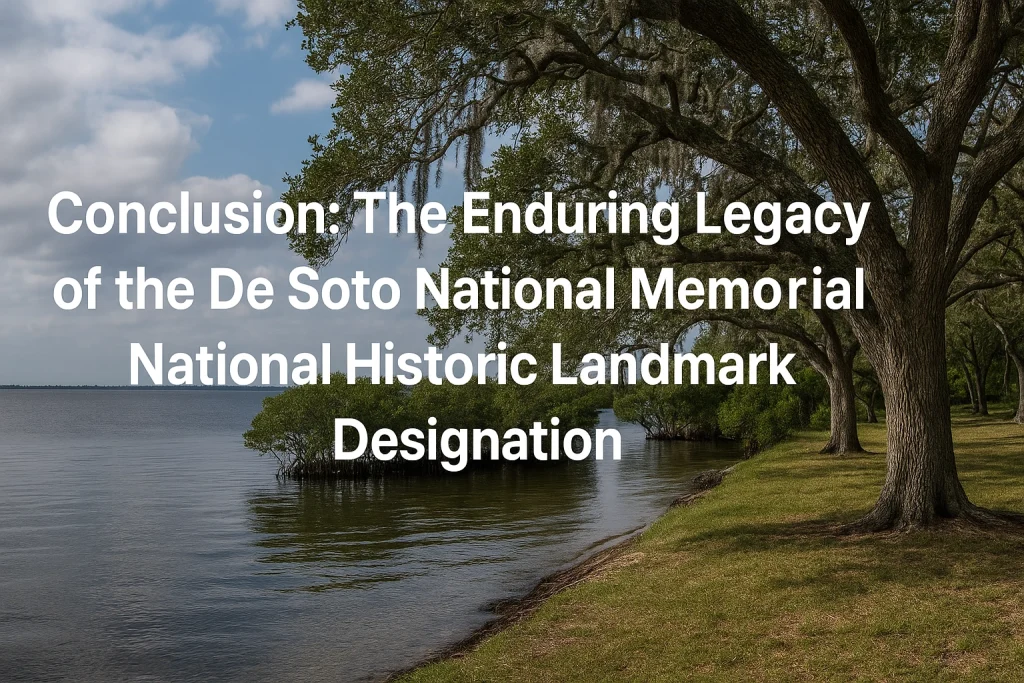
The De Soto National Memorial national historic landmark designation represents far more than an administrative title—it is a living testament to the nation’s ongoing commitment to preserve and interpret its complex past. This recognition ensures that the site, once the stage of Hernando de Soto’s 1539 landing and the early encounters between European explorers and Native American civilizations, remains protected as a place of learning, remembrance, and dialogue. Every trail, exhibit, and archaeological artifact preserved here contributes to a deeper understanding of how early contact shaped the cultural and environmental fabric of the American Southeast.
As a unit of the U.S. National Park Service, the memorial continues to serve as a vital educational and cultural resource. It bridges the gap between past and present by offering interpretive programs, archaeological research, and community engagement initiatives that illuminate the human stories behind the designation. The ongoing conservation of natural habitats—mangrove estuaries, shell mounds, and historical ruins—reinforces the idea that environmental stewardship and cultural preservation are inseparable components of heritage protection.
The significance of this designation also lies in its evolving role in public history and inclusive storytelling. Where older narratives once celebrated conquest, today’s interpretation strives to present a more balanced account—acknowledging the resilience of Indigenous peoples, the impact of colonization, and the ecological transformations that followed. Through exhibitions, reenactments, and educational outreach, the De Soto National Memorial continues to foster understanding and reconciliation, ensuring that visitors view history not as distant, but as deeply interconnected with contemporary values of diversity, respect, and stewardship.
Ultimately, the De Soto National Memorial national historic landmark designation serves as a model of how history, archaeology, and conservation converge to preserve the American story in all its complexity. It reminds us that designations are not simply about recognition—they are about responsibility: to protect, to educate, and to inspire. Standing on the tranquil shoreline of the Manatee River, visitors can sense that connection across centuries—a reminder that the past is not gone, but alive, safeguarded, and waiting to be rediscovered by each new generation.

